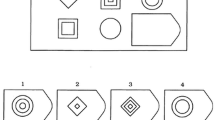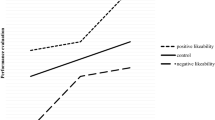Abstract
The imposter phenomenon (IP) is associated with a bias towards negative evaluation of one’s own performances. This study employs an online problem-solving task to investigate this bias. Participants (graduate students from the UK, US, and Europe; n = 163) solved reasoning problems and subsequently evaluated their performance. Participants high in IP evaluated their performances more negatively than participants low in IP. This pattern was observed both during the task and after completion. It was also observed in objective assessments (estimates of accuracy) and comparative assessments (estimates of rank amongst participants). Performance evaluation bias was not associated with a bias in the selection of feedback about performance nor was it mediated by depression or self-esteem.



Similar content being viewed by others
Data Availability
The dataset and code for this project are available on the Open Science Framework repository (https://osf.io/3n96e/).
References
Badawy, R. L., Gazdag, B. A., Bentley, J. R., & Brouer, R. L. (2018). Are all impostors created equal? Exploring gender differences in the impostor phenomenon-performance link. Personality and Individual differences, 131, 156–163. https://doi.org/10.1016/j.paid.2018.04.044.
Beck, A. T., Steer, R. A., & Brown, G. K. (1996). Beck Depression Inventory Manual (2nd ed.). San Antonio, TX: The Psychological Corporation Harcourt Brace & Company.
Blum, D., Holling, H., Galibert, M. S., & Forthmann, B. (2016). Task difficulty prediction of figural analogies. Intelligence, 56, 72–81. https://doi.org/10.1016/j.intell.2016.03.001.
Brauer, K., & Proyer, R. T. (2022). The Impostor Phenomenon and causal attributions of positive feedback on intelligence tests. Personality and Individual differences, 194, 111663. https://doi.org/10.1016/j.paid.2022.111663.
Bravata, D. M., Watts, S. A., Keefer, A. L., Madhusudhan, D. K., Taylor, K. T., Clark, D. M., Nelson, R. S., Cokley, K. O., & Hagg, H. K. (2019). Prevalence, predictors, and treatment of Impostor Syndrome: A systematic review. Journal of General Internal Medicine, 1–24.
Campbell, J. D., & Fairey, P. (1985). Effects of self-esteem, hypothetical explanations, and verbalization of expectancies on future performance. Journal of personality and social psychology, 48(5), 1097.
Clance, P. R. (1985). The impostor phenomenon: Overcoming the fear that haunts your success (kindle version ed.). Peachtree.
Clance, P. R., & Imes, S. A. (1978). The imposter phenomenon in high achieving women: Dynamics and therapeutic intervention. Psychotherapy: Theory Research & Practice, 15(3), 241. https://doi.org/10.1037/h0086006.
Clance, P. R., & O’Toole, M. A. (1987). The imposter phenomenon: An internal barrier to empowerment and achievement. Women & Therapy, 6(3), 51–64. https://doi.org/10.1300/J015V06N03_05.
Condon, D. M., & Revelle, W. (2014). The international cognitive ability resource: Development and initial validation of a public-domain measure. Intelligence, 43, 52–64. https://doi.org/10.1016/j.intell.2014.01.004.
Cozzarelli, C., & Major, B. (1990). Exploring the validity of the impostor phenomenon. Journal of social and clinical psychology, 9(4), 401–417. https://doi.org/10.1521/jscp.1990.9.4.401.
Ferrari, J. R., & Thompson, T. (2006). Impostor fears: Links with self-presentational concerns and self-handicapping behaviours. Personality and Individual differences, 40(2), 341–352.
Gadsby, S. (2022). Imposter Syndrome and Self-Deception. Australasian Journal of Philosophy, 100(2), 247–261. https://doi.org/10.1080/00048402.2021.1874445.
Gadsby, S., & Hohwy, J. (2022). Incentivising accuracy reduces bias in the imposter phenomenon. Current Psychology, 1–9. https://doi.org/10.1007/s12144-022-03878-2.
Holmes, S. W., Kertay, L., Adamson, L. B., Holland, C., & Clance, P. R. (1993). Measuring the impostor phenomenon: A comparison of Clance’s IP Scale and Harvey’s IP Scale. Journal of personality assessment, 60(1), 48–59. https://doi.org/10.1207/s15327752jpa6001_3.
Ibrahim, F., Göddertz, D., & Herzberg, P. Y. (2022). An experimental study of the non-self-serving attributional bias within the impostor phenomenon and its relation to the fixed mindset. Current Psychology, 1–10. https://doi.org/10.1007/s12144-022-03486-0.
JASP Team (2020). JASP. In (Version 0.14.1).
Kovacs, M., & Beck, A. T. (1978). Maladaptive cognitive structures in depression. American journal of Psychiatry, 135(5), 525–533.
Leary, M. R., Patton, K. M., Orlando, A. E., & Funk, W., W (2000). The impostor phenomenon: Self-perceptions, reflected appraisals, and interpersonal strategies. Journal of personality, 68(4), 725–756.
Lee, M. D., & Wagenmakers, E. J. (2014). Bayesian cognitive modeling: A practical course. Cambridge university press.
McGregor, L. N., Gee, D. E., & Posey, K. E. (2008). I feel like a fraud and it depresses me: The relation between the imposter phenomenon and depression. Social Behavior and Personality: an international journal, 36(1), 43–48.
Norem, J. (2008). The positive power of negative thinking. Basic Books.
Rohrmann, S., Bechtoldt, M. N., & Leonhardt, M. (2016). Validation of the impostor phenomenon among managers. Frontiers in psychology, 7, 821.
Rosenberg, M. (1965). Society and the adolescent self-image. Princeton University Press.
Sakulku, J., & Alexander, J. (2011). The impostor phenomenon. The Journal of Behavioral Science, 6(1), 75–97.
Stone-Sabali, S., Bernard, D. L., Mills, K. J., & Osborn, P. R. (2023). Mapping the evolution of the impostor phenomenon research: A bibliometric analysis. Current Psychology, 1–13.
Thompson, T., Davis, H., & Davidson, J. (1998). Attributional and affective responses of impostors to academic success and failure outcomes. Personality and Individual differences, 25(2), 381–396. https://doi.org/10.1016/s0191-8869(98)00065-8.
Thompson, T., Foreman, P., & Martin, F. (2000). Impostor fears and perfectionistic concern over mistakes. Personality and Individual differences, 29(4), 629–647. https://doi.org/10.1016/s0191-8869(99)00218-4.
Zanchetta, M., Junker, S., Wolf, A. M., & Traut-Mattausch, E. (2020). Overcoming the fear that haunts your success”–the effectiveness of interventions for reducing the impostor phenomenon. Frontiers in psychology, 11, 405.
Zimmermann, F. (2020). The dynamics of motivated beliefs. American Economic Review, 110(2), 337–361.
Acknowledgements
Thanks to the members of the Cognition and Philosophy and Dijkerman labs for helpful discussion; Manja Engel, Ryan McKay, and Jennifer Windt for written feedback; Simon van Baal and Jarl Kampen for analysis and coding advice; and Andrew Gadsby for figure design.
Funding
This study was funded by an Australian Government Research Training Program (RTP) Scholarship (S.G), a Monash University Postgraduate Publications Award (S.G.), a Fonds Wetenschappelijk Onderzoek (FWO) Postdoctoral Fellowship (1267022 N) (S.G), and the Faculty of Arts at Monash University (J.H).
Author information
Authors and Affiliations
Contributions
Stephen Gadsby contributed to the study conceptualization, data collection, data preparation, data analysis, report writing. Jakob Hohwy contributed to the study conceptualization and report writing.
Corresponding author
Ethics declarations
Ethical approval statement
Approval was obtained from the Monash University Human Research Ethics Committee (MUHREC Project ID: 25939) The procedures used in this study adhere to the tenets of the Declaration of Helsinki.
Conflict of interest
The authors report no conflict of interest.
Consent to participate
Informed consent was obtained from all individual participants included in the study.
Additional information
Publisher’s Note
Springer Nature remains neutral with regard to jurisdictional claims in published maps and institutional affiliations.
Electronic supplementary material
Below is the link to the electronic supplementary material.
Rights and permissions
Springer Nature or its licensor (e.g. a society or other partner) holds exclusive rights to this article under a publishing agreement with the author(s) or other rightsholder(s); author self-archiving of the accepted manuscript version of this article is solely governed by the terms of such publishing agreement and applicable law.
About this article
Cite this article
Gadsby, S., Hohwy, J. Negative performance evaluation in the imposter phenomenon. Curr Psychol 43, 9300–9308 (2024). https://doi.org/10.1007/s12144-023-05030-0
Accepted:
Published:
Issue Date:
DOI: https://doi.org/10.1007/s12144-023-05030-0




